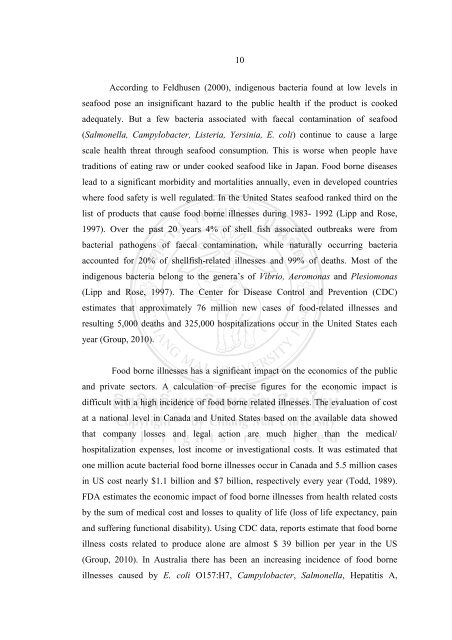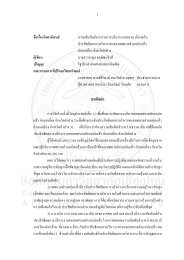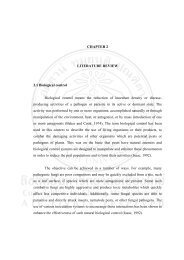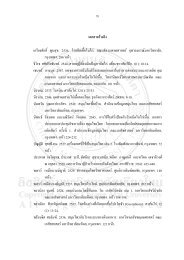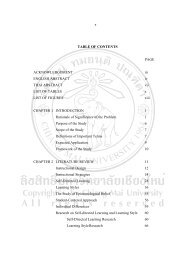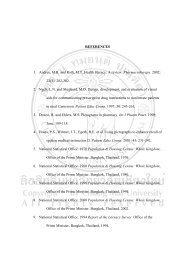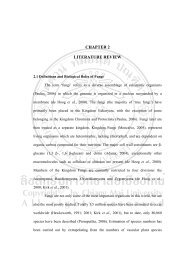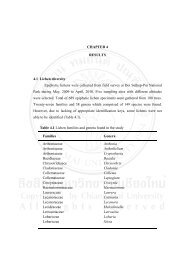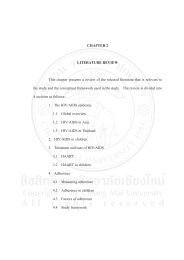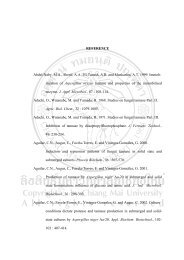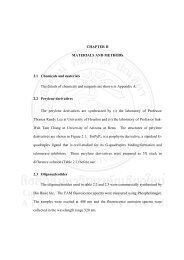prevalence and molecular characteristics of vibrio species in pre ...
prevalence and molecular characteristics of vibrio species in pre ...
prevalence and molecular characteristics of vibrio species in pre ...
You also want an ePaper? Increase the reach of your titles
YUMPU automatically turns print PDFs into web optimized ePapers that Google loves.
10<br />
Accord<strong>in</strong>g to Feldhusen (2000), <strong>in</strong>digenous bacteria found at low levels <strong>in</strong><br />
seafood pose an <strong>in</strong>significant hazard to the public health if the product is cooked<br />
adequately. But a few bacteria associated with faecal contam<strong>in</strong>ation <strong>of</strong> seafood<br />
(Salmonella, Campylobacter, Listeria, Yers<strong>in</strong>ia, E. coli) cont<strong>in</strong>ue to cause a large<br />
scale health threat through seafood consumption. This is worse when people have<br />
traditions <strong>of</strong> eat<strong>in</strong>g raw or under cooked seafood like <strong>in</strong> Japan. Food borne diseases<br />
lead to a significant morbidity <strong>and</strong> mortalities annually, even <strong>in</strong> developed countries<br />
where food safety is well regulated. In the United States seafood ranked third on the<br />
list <strong>of</strong> products that cause food borne illnesses dur<strong>in</strong>g 1983- 1992 (Lipp <strong>and</strong> Rose,<br />
1997). Over the past 20 years 4% <strong>of</strong> shell fish associated outbreaks were from<br />
bacterial pathogens <strong>of</strong> faecal contam<strong>in</strong>ation, while naturally occurr<strong>in</strong>g bacteria<br />
accounted for 20% <strong>of</strong> shellfish-related illnesses <strong>and</strong> 99% <strong>of</strong> deaths. Most <strong>of</strong> the<br />
<strong>in</strong>digenous bacteria belong to the genera’s <strong>of</strong> Vibrio, Aeromonas <strong>and</strong> Plesiomonas<br />
(Lipp <strong>and</strong> Rose, 1997). The Center for Disease Control <strong>and</strong> Prevention (CDC)<br />
estimates that approximately 76 million new cases <strong>of</strong> food-related illnesses <strong>and</strong><br />
result<strong>in</strong>g 5,000 deaths <strong>and</strong> 325,000 hospitalizations occur <strong>in</strong> the United States each<br />
year (Group, 2010).<br />
Food borne illnesses has a significant impact on the economics <strong>of</strong> the public<br />
<strong>and</strong> private sectors. A calculation <strong>of</strong> <strong>pre</strong>cise figures for the economic impact is<br />
difficult with a high <strong>in</strong>cidence <strong>of</strong> food borne related illnesses. The evaluation <strong>of</strong> cost<br />
at a national level <strong>in</strong> Canada <strong>and</strong> United States based on the available data showed<br />
that company losses <strong>and</strong> legal action are much higher than the medical/<br />
hospitalization expenses, lost <strong>in</strong>come or <strong>in</strong>vestigational costs. It was estimated that<br />
one million acute bacterial food borne illnesses occur <strong>in</strong> Canada <strong>and</strong> 5.5 million cases<br />
<strong>in</strong> US cost nearly $1.1 billion <strong>and</strong> $7 billion, respectively every year (Todd, 1989).<br />
FDA estimates the economic impact <strong>of</strong> food borne illnesses from health related costs<br />
by the sum <strong>of</strong> medical cost <strong>and</strong> losses to quality <strong>of</strong> life (loss <strong>of</strong> life expectancy, pa<strong>in</strong><br />
<strong>and</strong> suffer<strong>in</strong>g functional disability). Us<strong>in</strong>g CDC data, reports estimate that food borne<br />
illness costs related to produce alone are almost $ 39 billion per year <strong>in</strong> the US<br />
(Group, 2010). In Australia there has been an <strong>in</strong>creas<strong>in</strong>g <strong>in</strong>cidence <strong>of</strong> food borne<br />
illnesses caused by E. coli O157:H7, Campylobacter, Salmonella, Hepatitis A,


